![]()
|
IWC & JLC |
|
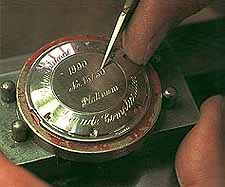 |
 The IWC factory ca. 1875 |
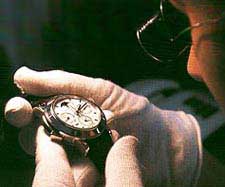 |
| In 1868, an American, Florentine Ariosto Jones, then just 27, was fascinated by the idea of uniting American expertise in automation with the legendary precision mechanics of the Swiss. It also seemed to him to be an interesting business proposition because, strange as it may seem to us today, Switzerland had extremely low wages and production costs. He first went to the French-speaking, western part of Switzerland, intending to mechanize the watch-making industry there. By American standards it was pretty backward. The entire process was carried out manually in people's homes - a veritable cottage industry. While attempting to get his ambitious plans off the ground, Jones met one Johann Heinrich Moser. Moser was a watchmaker and industrialist from Schaffhausen who had just built an advanced hydroelectric plant on the banks of the Rhine. Jones wasted no time in installing the machine tools, most of them imported from America, at premises in Schaffhausen. The International Watch Co. was born. | 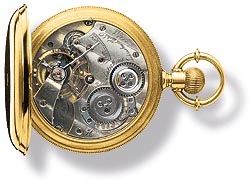 The original movement: the Jones calibre, finished on 15 September 1868, the year of the company's foundation. |
|
|
| It is also perhaps the perfect watch for
these last months and days of the 20th century, because
its owners will be able to observe an event that is rare
indeed: the changing of the millenium part of the date.
As any perpetual calendar should, it shows the correct
day, date, month, and year, no matter whether the month
has 28, 29, 30 or 31 days. It is also unusual in that it
shows the precise moon phase, not just an approximation. The watch on the right is just as amazing, even though it does less. The last time I was in Switzerland, I mostly stayed in a small village about 20 minutes from Zürich, called Brugg. It had a small pedestrian zone in the center (actually, the whole village qualified as "center"), which had a watch dealer who displayed in his window, among other things, an IWC Portofino perpetual date in gold on leather strap, deceptively simple, like the one here. The astounding thing is that the watch is no larger than a normal mechanical timepiece, and smaller than some, but has a perpetual calendar that even has a year indicator. Who cares that it is hand-wound - I would happily rotate that crown each day! Click on the left picture to go to the IWC discussion forum on TIMEZONE, the right one to go to IWC! |
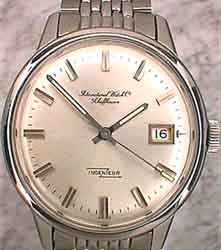 |
1954: The
Ingenieur, the first automatic IWC protected against
magnetic fields and featuring patented automatic winding
and a patented date display system (cal. 8521), goes into
production 1955: Hans Ernst Homberger takes over his father's company as the last private owner 1960: IWC sells 42,2 per cent of its watches overseas and in Asia, 38,3 per cent in Europe and 19,5 per cent in Switzerland 1976: IWC launches the new Ingenieur SL Expressions of the essence of their respective eras: the original Ingenieur on the left typifies the style of 50s watch design, and perhaps the same will be said for the new model on the right in a few decades. |
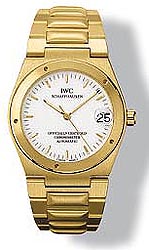 |
| IWC
seems rather proud of its Ingenieur; they neglect purely
technical considerations, like the fact that the movement,
cal. 887/2, is a dressed-up version of the one in the
Mark XII, which is based on a Jaeger-Le Coultre, but they
describe the watch as such: Anyone who remembers its predecessors, and its pre-predecessors, will not be surprised in the least by its clean, simple lines: after all, understatement is part of the family tradition. But there is no false modesty in relation to its absolute perfection, which is written - literally - on its face: «Officially Certified Chronometer». It's been independently tested by a neutral authority, the Swiss Official Chronometer Testing Institute, during attempts to throw its accuracy off balance by changing temperatures and different positions. For no less than 14 days and nights. And so you can be sure that what you have in your hands has also been tested in this way, you will receive with your watch a certificate confirming that it has attained the standards demanded by the Swiss Official Chronometer Testing Institute. |
 |
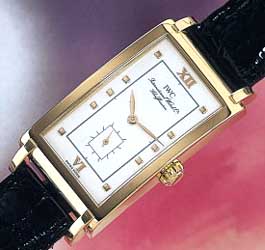 |
 |
| The range of IWC products is impressive, and the three models above are just a taste of the whole line. On the left, one of their classics, the superb Portuguese, here a minute repeater version, in the middle, the Venezia, and on the right another unique classic, the Novecento, a square automatic with perpetual calendar. |
| The four watches below are new models for 1999, like them or not! Ref. 3752, the Da Vinci Tourbillon: A limited edition, the Da Vinci Tourbillon has a tiny escapement encased inside a rotating cage. IWC's illustrious chronograph-cum-perpetual calendar, here with a hand-wound movement, is the Schaffhausen company's homage to the end of the mechanical millennium. Ref. 3527 GST Deep One: Going down. The Deep One from IWC is a professional instrument for the amateur diver. It combines a mechanical wristwatch and automatic movement with a dive timer and a mechanical depth gauge with maximum depth indicator. The titanium case and bracelet are in the familiar GST sports watch design. The watch is supplied with a Velcro strap, which can be fitted easily and without special tools and makes it possible to wear the watch over a dive suit. Ref. 3253, the Mark XV: Fitted with a new automatic movement (ETA!!) in a larger case (38 mm in diameter), it has kept the main features of the Mark XII : perfect legibility in all conditions and, thanks to an inner case made of lead, protection against magnetic fields. With its larger size, black dial and luminescent hour markers, it has taken on a resolutely functional character. Ref. 3712, the Portugieser Rattrapante: The Portuguese watch introduced in 1993, a limited edition of the original version dating from the 1940s, rapidly became a legend in its own right. This chronograph model has a third button for the IWC split-seconds mechanism. For the Portuguese family a voyage into new territory, which they can also take protected by either a platinum, stainless steel or new a 18ct. white gold case. |
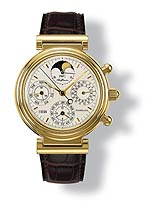 |
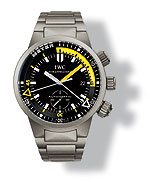 |
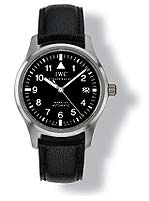 |
 |
 Antoine LeCoultre |
In 1803, Le Sentier saw the birth of a boy who was to make the name LeCoultre world-renowned. Descendant of Pierre LeCoultre who settled in Le Sentier in 1559, Antoine LeCoultre was the son of Henri-David, owner of a forge which produced mechanical instruments. It was here that he completed his apprenticeship and specialized in metallurgy and gear-mechanisms. In 1903, Jacques-David LeCoultre entered into a business relationship in Paris with the chronometer-maker Edmond Jaeger. This partnership opened the way into the luxury market for LeCoultre and resulted in the name of Jaeger-LeCoultre, that was to become synonymous with high-grade watchmaking. | 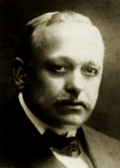 Edmond Jaeger |
| In watch circles, Patek Philippe
is considered Royalty and Nobility is represented by
Jaeger-LeCoultre. Not only does Jaeger produce some of
the finest watches in existence, but they are one of the
last true manufacturers of watches, producing some of the
most desirable timepieces on the market. They actually
supply many other watchmakers with movements, among them
their sister-company IWC. On the left are two special
editions of the Master Control, a watch whose
quality controls exceed those of the official chronometer
institute. On the left, the Master Geographique with a
second, adjustable time zone, on the right the Master
Perpetual, both in platinum. Click on either one to go to the Jaeger-LeCoultre web site! |
| Among all Jaeger models, a place of honor is reserved for the Reverso. Just thinking of the name or looking at the pictures gives you a special kind of feeling of reverence mixed with nostalgia. The original Reverso dates to 1931, myth has it that British polo players demanded a device to protect their timepieces while on the field (rather than taking them off, I suppose), so the original "flip around" watch was created, believe it or not! |
|
|
| Occasionally, a true design classic appears on the scene that is timeless in its appeal. It reminds me of the story of the Volkswagen Beetle, which was recently reissued in a modern update that is at once reminiscent of the old beast, while eminently more usable. I should know, because I had two Beetles, the first one a 1964 leftover from my parents, with a 34 horsepower engine (!), a trunk that held a flat briefcase and that notorious ventilation system that made all the windows fog up in the slightest humidity. Remember those two semi-circular openings on the windshield, created by the blower? Anyhow, just like people tinkered with their Beetles to personalize them, so has Jaeger tinkered with the good old Reverso to come up with ever more stunning models. Here are two of their marvels, the Reverso tourbillon and repetition minutes, both amazing in their technical qualities. |
|
The extremes of the skill of Jaeger-LeCoultre's craftsmen are represented by the late, much lamented Le Grand Réveil on the left and the Master Control Grande Taille on the right. The impressively-sized Réveil does not only have an alarm, but also a perpetual calendar. Pretty much all it doesn't do is shine your shoes. The Master Control, on the other hand, to my mind comes as close as can be to the perfect everyday watch. It is impeccably crafted, tested to specifications that surpass those of the Chronometer Institute, is automatic with date, and beautifully understated. |
|
| I recently chatted with my friendly neighborhood watch repair man, an elderly Swiss guy, who lamented the good old days when the company he worked for in Switzerland made what they designated "master watches," what one might call reference timepieces. Well, they are still around, here is one of them! If you take a close look at the cover of GQ for March 1999, you will see that someone put a Master Ultraflat on Russell Crowe's arm. To me, that seems about as appropriate as putting a tutu on a bull. |
 |
Preserving the spirit of the Reverso, the case of the Reverso Gran'Sport is naturally reversible, but also water-resistant to a depth of 5 atmospheres. To prevent undesired swivelling, a new system guarantees that the case stays in place in case of accidental jarring. The Reverso Gran'Sport features an integrated bracelet. Its extremely sophisticated clasp, made up of 52 parts, is doubtless the most complex in the world. |
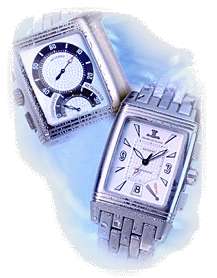 |
| The bracelet's quick summer/winter or morning/evening length adjustement enables fine adjustement over 2x4 mm of leeway. The dial of the Reverso Gran'Sport, in a choice of silvered or charcoal-grey hue for both models, features grenadier type guilloché patterns with inner minute-track, dagger appliques and special tritium-coated Jaeger-LeCoultre hands. |
| Page 1: hello |
Page 2: nice things |
Page 3: Audemars Piguet |
Page 4: IWC, JLC |
Page 5: Patek Philippe |
| Page 6: Flieger |
Page 7: more Flieger |
Page 8: Zenith, Eberhard |
Page 9: chronographs |
Page 10: big money! |
| Page 11: mo' money |
Page 12: more chronos |
Page 13: less known gems |
Page 14: moonstruck |
Page 15: pictures & links |